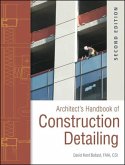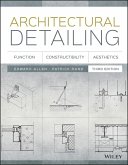Why are buildings detailed the way they are?
Why do architects and engineers seem to come to the same kind ofsolutions to their detailing problems?
Are we satisfied with such a situation?
With environmental concerns so high on designers agendas, theanswer to this third question has to be no . Collectivelyarchitects, engineers and specifiers need to revisit how theydetail the built environment, and address the most important andpotentially difficult area of the joint between materials andcomponents.
In Principles of Architectural Detailing the authors question theway in which buildings are detailed and in particular challengefamiliar joint solutions. They offer practical guidance and anumber of tools to help the student of architectural detailing inthe decision-making process. The emphasis throughout is on usingknowledge of construction in a creative and productive way tocontribute towards a built environment that enhances our well-beingand which is also sustainable.
Why do architects and engineers seem to come to the same kind ofsolutions to their detailing problems?
Are we satisfied with such a situation?
With environmental concerns so high on designers agendas, theanswer to this third question has to be no . Collectivelyarchitects, engineers and specifiers need to revisit how theydetail the built environment, and address the most important andpotentially difficult area of the joint between materials andcomponents.
In Principles of Architectural Detailing the authors question theway in which buildings are detailed and in particular challengefamiliar joint solutions. They offer practical guidance and anumber of tools to help the student of architectural detailing inthe decision-making process. The emphasis throughout is on usingknowledge of construction in a creative and productive way tocontribute towards a built environment that enhances our well-beingand which is also sustainable.








